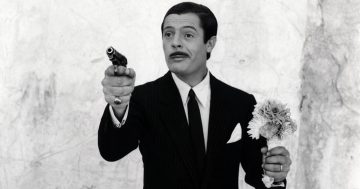Buster Keaton
Film Art
We could make this publication thanks to small donations. How is 3 minutos de arte supported?
Buster Keaton’s Humor
Buster Keaton is one of the most representative artists of physical humor (the humor that prevailed in the era when movies were silent and words could not be used to make people laugh). But his humor is different from that of other comedians due to two characteristics that place this artist next to Chaplin (others would say “close to Chaplin”) when talking about the greatest in the history of cinema.
Those two key characteristics that make his hilarious humor unique are:
. First, Buster Keaton never smiled (not even off-screen, in his daily life), and his face never conveyed emotions in keeping with the situation. This means that his characters, usually unfortunate and tragicomic, face crazy misfortunes with total inexpressiveness. For this very reason, he is called The Great Stone Face. He said in an interview at the end of his career when and how he discovered the potential of this resource: “Well, you see, I learned that from the stage, that I was the type of comedian that if I laughed at what I did, the audience didn’t. So I just automatically got to that stage where the more seriously I took my work, the better laughs I got. So by the time I went into pictures, not smiling was mechanical with me.”
Keaton worked as a variety performer in the theater with his parents, doing mime and acrobatics from a very young age. Clearly, as his home was the theater during his childhood, the young Keaton knew how to make audiences laugh. When he entered the world of cinema at the age of 21, he had a lifetime of experience. He was already a veteran of humor.
. The second key to his humor is his acrobatics, which at times are heart-stopping. Keaton generates dazzling scenes through his display of physical skill, often at high risk, without special effects, optical illusions, or stuntmen. Let’s keep in mind that, precisely, the humor of those years was physical humor, and at times Keaton did things that were physically almost impossible or extremely dangerous (many times he really risked his life, and at others he was wounded). With these acrobatics, Keaton added to the comedy very primary emotions such as astonishment and fear, adding extra values that gave intensity to the scenes. This fact is fundamental when watching his short films and movies today: those amazing scenes may have been commonplace for decades, due to stuntmen and special effects, but when we understand that when Keaton was doing them, he did not know if he was going to finish the scene in one piece, that’s when we appreciate his talent even more. And that’s why we laugh even more.
Comparing Buster Keaton and Chaplin: an unavoidable nonsense
We can say that Keaton’s humor and Chaplin’s are different. Both are admired for different qualities, and it is difficult for those who know both to decide who the best is (if that were important).
There is a fundamental point that contributed greatly to Chaplin’s career being much more successful. Although Chaplin is nicer, he smiles, and he moves the audience with his tragic stories, the crucial thing for his career is that he did not allow sound films to marginalize him and always counted on something fundamental: his creative freedom. Chaplin always believed in independence because the production companies that employ you can also put an end to your career. And thus, in 1919, he became one of the founders of the United Artists Corporation, so that all his life he could do what his intuition, his fabulous creativity, and his desire dictated.
For Keaton, on the other hand, the arrival of the sound film was a tragedy. Until that moment, when Keaton came up with an idea for a short or feature film, he left the details of the script to his collaborators. The script is the least important thing. The important thing is the humorous scenes, and that’s what he did almost exclusively. A phrase of his is: “You can write the story of a film on a postcard.”
But when sound films arrived, they arrived with words. And then the script became relevant. The gestural and the physical were accessories to the word; they were the background. The humor of the sitcoms and dialogues was important. The freshness of improvisation was lost.
Buster Keaton, an employee of a production company without the autonomy to follow his intuition and creativity, was gradually marginalized, and he got down in the dumps. His attempts to adapt to sound films were unsuccessful. And for a couple of decades, they faded away, until in the fifties, the old silent films were screened again. When that “miracle” took place, Keaton regained his popularity and never ceased to be vindicated with a place among the greatest.
His humor has no expiration date.
Recommended links:
Charles Chaplin and his character Charlot.
The Three Beginnings of Cinema.
Georges Méliès and the Magic of the Cinema.
The First Comedy Film of the History of Cinema.
The Golden Age of Hollywood (Classic Hollywood Cinema).
You can also find more material using the search engine.




0 Comments